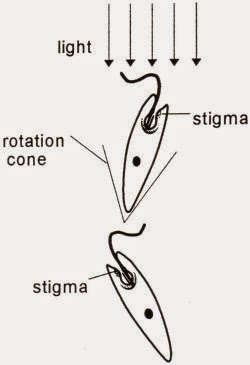Locomotion is the ability of an organism to move from one
place to another. Different organisms have evolved various mechanisms for
movement, depending on their body structure and environment. In this article,
we will explore the different methods of locomotion found in protoctista
(unicellular organisms) and invertebrates (animals without a backbone).
Understanding these movement mechanisms helps us appreciate the diversity of
life and how organisms adapt to their surroundings.
Locomotion in Euglena
Euglena is a highly active microorganism that moves swiftly
using a long whip-like structure called a flagellum, located at its
anterior end. Movement occurs due to the lashing motion of the flagellum
against water. This flagellum follows a 9+2 fibril arrangement, where
five fibrils contract to bend the flagellum, and four fibrils contract to
straighten it. This action propels Euglena forward in a rotating motion.
Additionally, Euglena can change its direction using
contractile myonemes along its body. The contraction of these myonemes alters
its shape and movement, a process known as euglenoid movement.
Locomotion in Paramecium
Paramecium moves rapidly using numerous hair-like structures
called cilia, a movement known as ciliary movement. The cilia do
not move simultaneously; instead, they beat in a coordinated, wave-like manner.
As the wave starts from the anterior end, the body rotates while moving
forward.
Structure of Cilia
- Cilia
are fine thread-like extensions of the cell membrane.
- Their
length varies from a few microns to several hundred microns.
- They
consist of nine peripheral fibrils arranged in pairs (doublets)
and two central fibrils, forming the 9+2 microtubule structure.
Mechanism of Ciliary Movement
- Effective
stroke: Five out of nine fibrils
contract, bending the cilium.
- Recovery
stroke: Four fibrils contract,
straightening the cilium.
- The
movement is powered by ATP and regulated by the enzyme ATP-ase.
- Thousands
of cilia beat together, coordinating movement.
 |
| Locomotion in Paramecium |
Locomotion in Amoeba
Amoeba moves using pseudopodia, which are temporary
extensions of its cytoplasm. This type of movement is called amoeboid
movement.
Mechanism:
- Movement
starts with local weakening in plasmagel (hyaline ectoplasm).
- The
inner plasmasol (endoplasm) flows into the weakened region due to
contraction of the elastic plasmagel.
- Osmotic
forces drive this contraction.
- The
bulk of the Amoeba’s body shifts forward, changing its position.
 |
| Locomotion in Amoeba |
Locomotion in Jellyfish
Jellyfish move by a method called jet propulsion.
Their body consists of an umbrella-like structure called a bell.
Mechanism:
- Water
enters the bell.
- The
jellyfish contracts its bell, forcing water out in a jet-like motion.
- This
pushes the jellyfish upwards.
Locomotion in Earthworm
Earthworms use setae (bristles) for movement,
following an accordion-like motion.
Mechanism:
- The
setae in the posterior part attach to the soil.
- Circular
muscles contract, pushing the anterior part
forward.
- The
anterior setae attach to the soil while the posterior setae are
withdrawn.
- The
longitudinal muscles contract, drawing the posterior part forward.
- The
process repeats, allowing smooth crawling motion.

Locomotion in Earthworm
Locomotion in Cockroach
Cockroaches use three pairs of legs for walking and two
pairs of wings for flying.
Walking:
- The
legs on one side move together.
- The
foreleg pulls the body forward, the hind leg pushes, and the
middle leg acts as support.
- The
three remaining legs repeat this action, moving in coordination.
- Antagonistic
muscle pairs control movement.
Flying:
- The
posterior pair of wings generates lift and thrust.
- The
wings beat in a specific manner to support body weight and propel it
forward.

Locomotion in Cockroach
Locomotion in Snail
Snails move very slowly using a muscular foot, which
contracts in a wave-like motion, enabling crawling.
Locomotion in Starfish
Starfish use tube feet for movement, attaching and
releasing from the surface in a coordinated manner.
Mechanism:
- One
or two arms are raised in the direction of movement.
- Suckers
of tube feet attach to the surface using vacuum
action.
- Circular
muscles contract, elongating the tube feet and
pulling the body forward.
- Longitudinal
muscles contract, forcing water back into
ampullae, releasing the suckers.
- The
process repeats, allowing steady movement.
So what
we learned is:
Locomotion
is a key characteristic of living organisms, allowing them to move in search of
food, escape predators, and interact with their environment. From the flagellar
motion of Euglena to the jet propulsion of jellyfish and the coordinated muscle
contractions of earthworms, nature has developed diverse and efficient ways for
organisms to travel. Understanding these mechanisms provides insight into the
adaptability and survival strategies of different species.



No comments:
Post a Comment